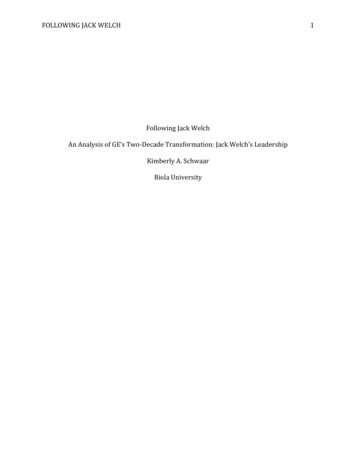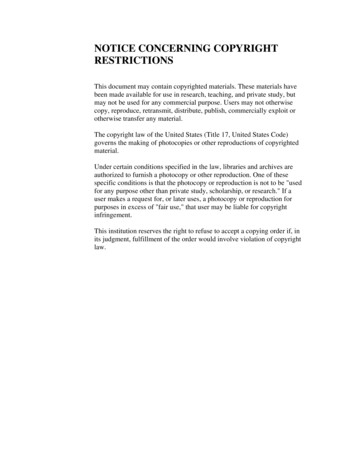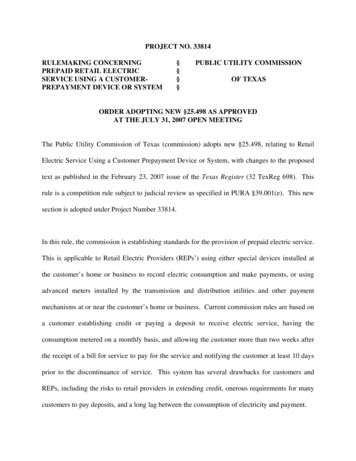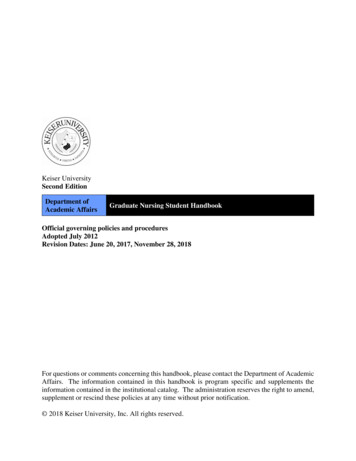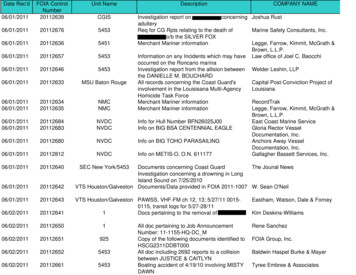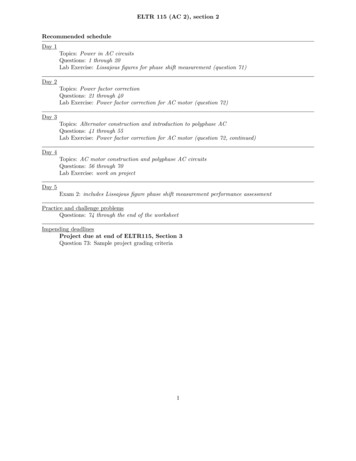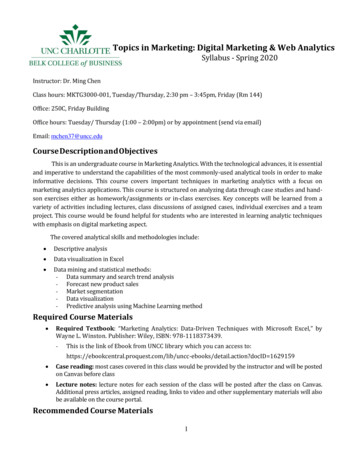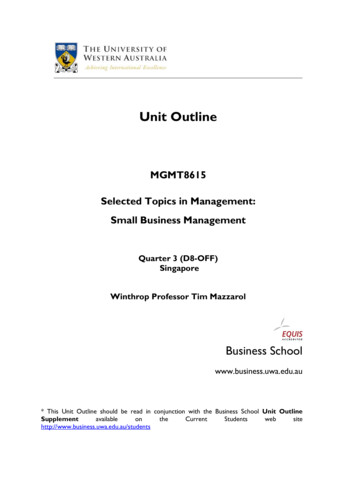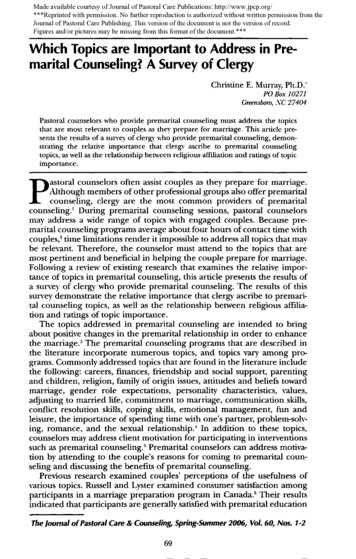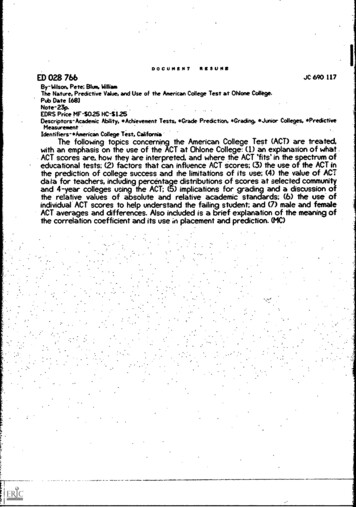
Transcription
DOCUMENTRESUMEED 028 766JC 690 117By-Wilson. Pete; Blum. WilliamThe Nature, Predictive Value, and Use of the American College Test at Oh lone College.Pub Date 1681Note-23p.EDRS Price MF-S025 HC-S1.25Descriptcrs- Academic Ability, *Achievement Tests, *Grade Prediction, *Grading, *Junior Colleges, *PredictiveMeasurementIdentifiers-*American College Tests CaliforniaThe following topics concerning the American College Test (ACT) are treated,with an emphasis on the use of the ACT at Ohlone College: (1) in explanation of whatACT scores are,, how they are interpreted, and where the ACT 'fits' in the spectrum ofeducational tests; (2) factors that can influence ACT Scores; (3) the use of the ACT inthe prediction of college success and the limitations of its use; (4) the value of ACTda ta for teachers, including percentage distributions of scores at selected communityand 4-year colleges using the ACT; (5) implications for grading and a discussion ofthe relative values of absolute and relative academic standards; (6) the use* ofindividual" ACT scores to help understand the failing student; and (7) male and femaleACT averages and differences. Also included is a brief explanation of the meaning ofthe correlation coefficient and its use in placement and prediction. (MC).
U.S. DEPARTMENT OF HEALTH, EDUCATION & WELFAREOFFICE OF EDUCATION.0THIS DOCUMENT HAS BEEN REPRODUCED EXACTLY AS RECEIVED FROM THE1/40PERSON OR ORGANIZATION ORIGINATING IT.POINTS OF VIEW OR OPINIONSSTATED DO NOT NECESSARILY REPRESENT OFFICIAL OFFICE OF EDUCATIONCOPOSITION OR POLICY.r\Jtc)THE NATURE, PREDICTIVE VALUE,AND USE OF TIE AMERICANCOLLEGE TEST AT OHLONE COLLEGE1.-11-31%LOS ANCELESAPR 1 4 1969CLEARINGHOUSE FORJUNIOR COLLEGEIf\mr,--- 4
This paper was prepared for theOh lone College Faculty by Pete Wilson-working in collaboration withthe Dean of Students, TAM Blum
TABLE OF CONTENTSPage1What are ACT Scores?3What Influences ACT Scores'Table I - Selected College ACT Averages56What do ACT Scores Predict?Of What Values are ACT Scores to Teachers'Table II - Percentage Distributions of ACTScores for Selected Community Colleges1213Table III- Percentage Distributions of ACT Scoresfor Selected CollegesTable IV - Ohlone College and State CollegeComparisonsImplications for Grading .ACT Scores and the Individual Student1516.17Sex:Differences in ACT ScoresTable V - Male and Female Averages ofACT Scores/Tote on the Correlation CoefficientReferenceslr
-1-What are ACT Scores?Tests used by educational institutions cover a considerable variety of content.These tests can be arranged along a spectrum ranging from those which arestrictly measures of outcomes of education to those which are nost independentof specific instruction.Here is the spectrum and some examples.Tests Most De endent on Education1.ExamplesSubject Matter ProficiencyTeacher-nade examsUSAFI Achievement Tests2.General Educational DevelopmentIowa Tests of Educ. DevelopmentScholastic Aptitude Tests of CEEBAmerican College Test (ACT)Reading, Vocabulary, ArithmeticSchool and College Ability Tests (SCReasoningOhio State Psychological (OSU)4.Verbal Analogies; Number SeriesAmerican Council on Education (ACE)5.Figure Series; MatricesParts of Differential Aptitude Tests3.Raven Progressive Matrices6.Learning SamplesSemantic Test of IntelligenceTests Least De endent on EducationSame tests are "wide;-band".test including nore than one level of questions.Forexample, the Scholastic Aptitude test of the College Entrance Examination Boardincludes neasures of both general abilities and adhievement in relatively specifisubject areas.The ACT, as you can see, is much closer to the upper end of the spectrum and isthus considered nore of a measure of educational outcome (achievement) and lessa measure of "culture free" intelligence.Lee Cronbach, am expert in this area,has this to say about the spectrum of tests,The functions of the tests at the two ends of the spectrum are different.Those toward the top are designed for cold-blooded prediction of futureschool success. One who has done poorly in past schooling is a bad bet forthe future, no matter what his "intelligence" may be. Those who admitstudents to college or award college scholarships rarely take a chanceon the student "who would succeed if he turned over a new leaf". Theyprefer the test which deliberatel handica s the student who has hadpoor schooling or has takenlittleallyaktageoLit. On the other hand,the teacher or counselor working with a student wants to know what undeveloped resources he has. The mental test ought to locate undeveloped
-2-potential that novel treatment (teaching methods) may bring out.For fhispurpose tests which have a minimum of overlap with achievement will providethis information. Tests in the range of five and six on the spectrum arepreferable when it is necessary to compare persons coming from differenteducational and cultural backgrounds. The more different the backgrounds,the farther toward six the test shrld be, unless a particular class requires some specific background.(3,p. 236)The ACT represents a part of a shift in recent years away from tests designed tomeasure nmental ability" as distinct fram achievement toward tests that maximizeefficiency in the prediction of school success.The ACT is more of a test ofachievement than a test of intelligence with its measure of "academic potential"in four subject areas and a composite score thought to he important for collegesuccess.The four areas are English, Mathematics, Social Studies, and NaturalScieace.Scores in each of these areas and the composite score axe reported in standardscores. A standard score is a score which has been transformed from the numberof correct answers.The reason for transforming the scores is to equate theresults of the various subtests by taking into account their relative difficulty,the number of questions and the range of individual differences.Thus a standardscore of 20 indicates the same relative standing, on a national basis, on any ofthe ACT sdbtests or the composite score.the test measures what it measures.ACT scores also reflect how consistentlyIn technical terminology, one standardscore point is equal to the probablo:error of measurement.This means that if astudent makes a standard score of 20, the odds are 1 out of 2 that his "true"1score is between 19 and 21. The chance his score is over 21 is 1 out of 4 andit is also 1 out of 4 that his score is below 19.(1, p. 65)The interpretation of these scores is achieved by systematically comparing thescores of individuals or an entire institution with typical performances ofselected freshmen groups.The comparisons are based on averages, standarddeviations and percentile ranks of the entire classes of entering college freshmen.Some of these comparisons are discussed in another part of this paper.1A "true" score would be the average score of a student who has taken the testaa infinitely large number of times.
What Influences ACT Scores?Variations in community averages of scholastic achievement test scores areassociated with a variety of factors.On a test comparable to the ACT theregion of the country is a correlate of test scores.Generally speakingscores are higher in the East, North, and Far West and lower in the Southand South West. (10, p. 5)Percent of FreshmenExceeding National StandardArea of ResidenceNew EnglandMiddle AtlanticEast North CentralWest North CentralSouth AtlanticEast South CentralWest South 525The size and location of the community is related to community averagescores of high school seniors.Large metropolitan communities tend tohave higher average scores than small rural communities. (2, p. 8) Withina large metropolitan area the suburban areas will usually makescores than the central city or ghetto areas.hiegverageThe lower scores are correlatedwith higher percentages of minority students and students from lower socioeconomic levels residing in the central cities.As might be expected, the percentage of fathers in a community who are highschool graduates is positively correlated with the average test scores of thehigh school seniors in those communities.(2, p. 8)Perhaps less well known is the positive correlation between the percentageof state vs. local financial aid for education and the state-wide averages ofscholastic achievement test scores.The greater the proportion the state con-tributes, the higher the averages. (2, p. 8)Even such factors as tiae average educational expenditure per student and thenumber of books in public libraries per 1,000 of the population can add positively to the prediction of average scholastic test scores of high school seniors.(2, p. C)
-4-On an individual basis (vs. the community averages we have been discussing) afactor such as the IQ of parents, with their education and socio-economicstatus held constant, is associated with measured academic potential.(9, p. 11)Also positively correlated are education of parents, income of parents, occupation of father (5, p. 110) and as mentioned earlier, area of residence withina city:In interpreting the average ACT scores of various colleges, many factors mustbe kept in mind,Probably che most important factor is the admissir-s policy.If admissions are based on high sdhool grades or on test scores or a combinationof both, this mill drastically affect the average test scores.For example,the University of California tries to admit from the top one eighth of thegraduating high school seniors and the State College system tries to admit fromthe top one third.That factors other than admission policies affect averagetest scores can be seen from the variation of average scores among state collegesand various campuses of the University (See Table I).In theory, Californiacommunity colleges drao fnom the top one hundred percent.In fact, they drawa high proportion from the lower fifty percent.The reputation of a college affects the type of student it attracts.Collegeswith a reputation for having an exciting intellectual atmosphere as contrastedto a vocational orientation will probably attract academically more able students.Loth lay and professional opinion are important in this respect.Boththe opinions of a student's peer group and the opinions of his parents will influence his choice when problems of grades, money, and transportation are notdominant.The professional opinions of high school counselors and teacherscan also exert an influence.Unfortunately many high school counselors urgetheir students to go to the university if they can, to the state college as asecond choice, and to a local community college as a last resort.In the case of community colleges their average ability test levels are inpart a function of the ability levels and quality of education in the highschools fromi which they draw most of their students.Some high schools con-sistently send better prepared students to a community college than do others.Other variables which probably influence the choice of the potential communitycollege student are the alternatives available in terms of distance to a fouryear institution and the cost of attendance at those institutions.Last, butnot necessarily least, are the institutional relationships between the highschool and the community college.This would include the aggressiveness of re-cruiting policies in working with high school counselors, principals, andteachers.
.5.TABLE I3ELECTED COLLEGE ACT AVERAGESACTCompositeMeanNational**Percentile RankEquivalent toMean of *56444756524947400,01.48MftUniversitiesU.C. BerkeleyU.C. DavisU.C. Los AngelesU.C. Santa BarbaraStanford UniversityUniv. of Santa ClaraUniv. of Southern Cal.Calif. Inst. Tech.Univ. of San FranciscoUniv. of PacificHarvard UniversityMass. Inst. Tech.Princeton UniversityYale 18379966564MftftMiscellaneousGolden Gate College17.7*31National Sample of 329 Colleges (all types)Community. CollegesOhlone ('67)Psych. 1 Classes - OhloneHealth Classes - OhloneMhrin, Foothill, Contra Costa SierraDiablo Valley, Santa RosaA Bay Aria Community CollegeSeven Bay Area Community CollegesState CollegesThree Calif. State CollegesCalif. State College 'A'Calif. State College 'B'San Francisco StateChico StateLong Beach StateSan Diego StateSan Fernando StateHumboldt StateFresno StateSacramento lee010104111MlimMMOW.MOP*90WOW*Predicted, not actual means.**Based on 150,053 freshmen students from 329 colleges and universities. Thepercentile ronk gives the percentage of cases equal to or below a given score onnational norms.
-6-What Do ACT Scores Predict?One of the "laws" of educational psychology is that the "final" characteristics,including levels of achievement, of students undargoing an educational experience are more a function of "initial" characteristics than any other factor.A special case of this "law" is involved in the ACT and high school GRA (gradepoint averages).On a national basis, but not at Ohlone College, high schoolGPA is the best single predictor of college GPA.tends to be the second best single predictor.ALT nr a comparable testA combination of the two char-acteristics is a better predictor than either alone.This "law" does not denythat other factors such as quality of teaching, ability grouping, class size,teaching materials, etc., nay also influence academic achievement; it does implythat on the average none of these factors is nearly as potent as the level ofacademic potential with which students enter a class.Nbtice also tht the "lawdoes not predict the amount of learning (improvement or gain), only the finallevel of achievement.This achievement level is hmperfectly indicated by lettergrades.At the national level using the Pearsonian correlation coefficient1as themeasure of predictive efficiency, ye find that high school GPA correlates ,54with college GPA.correlate .602ACT correlates .48 with college GPA.Both factors combinedwith college M. At Ohlone College high school GPA correlates.22 with college GPA.ACT correlates .41 with Ohlone College GRA and bothfactors combined correlate .423with Ohlone College GPA.See the explanatory note at the end of this paper for a discussion of thecorrelation coefficient.2A correlation of this size would eaable one to predict GPA plus or minus .61of a grade point for two out of three students on the average.(For a pre-dicted GPA of 2.5 the expected range would be 1.89 to 3.11.)3A correlation of this size would enable one to predict GPA plus or minus .71of a grade point for two out of three students on the average.t\Of the five ACT subtests - Engliih, math, social studies, natural science, and%composite - scores in English correlate as high or higher with both highschool and college grade point averages than any other score.Apparently a1knowledge of English is the factor most important for success in school.
7-Other correlations are given below:High School GradesCorrelation withOhlone overall GPAACT Subject testsCorrelation withOhlone overall GRA.15.09.17.15.21.39.24.33.26.38EnglishMathSocial StudiesNatural ScienceCompositeACT Composite - Psychology 1 grade r .47H.S. Grade Average - Psychology 1 grade r .29ACT and H.S. GPA - Psychology 1 grade r .51 (multiple correlation)ACT Composite - Health Ed. grade r .44Grade Average - Health Ed. grade r .20ACT ati H.S. GPA - Health Ed. grad2 r .44 (multiple correlation)ACT Composite - overall GPA r .441 (multiple correlation)H.S. Grade Average - overall GPA r .22 (multiple correlation)ACT and H.S. GPA - overall GPA r .42 (multiple correlation)between high school GPA/One might wonder about the relatively low correlationsACT test scores and grades at Ohlone College. While there is no hard datarelativelyavailable, it is possible to speculate about the reasons for thelow correlations. As can be seen in the following list, nany of the reasonsare inherentthe nature of the community college.The possible reasonsfor the low correlation include:1.Skewed distribution of ACT scoresFor a correlation coefficient to reach its maximum, both predictorand predicted scores nust form the normal bell-shaped curve whenarranged around the middle of a continuum of scores.While fewcolleges would have a perfectly normal distribution, Ohlone students'scores are probably more skewed toward the law end of the continuum.2Ambiguity of high school gradesStudents entering four year institutionu have for the most parttaken college prep courses where one standard of grading prevailed.Students entering comnunity colleges are more apt to have takencollege prep, vocational, and/or remedial courses where a variety ofgrading standards may have been used.Thus, the meaning of the gradepoint average of two students entering a community college may differeven though they are numerically the same.For a neximum correlationthe high school grades would have to reflect a single continuousscale.
3.Ambiollity of Community College GradesGrade point averages of community college students are more apt toreflect achievement in vocational-technical courses as well as inart, music, and drama where varied criteria of achievement may beused.Students attending a small community college may actuallyrealize more of their potential (especially in the above-mentionedareas) than ACT scores would predict if these same people hadattended a four-year institution because of more extensive andintensive opportunities for participation at the community college.If they receive an "A" for being a first string tackle, having alead role in a play, or being first chair in the orchestra, theyare in a sense "over achieving."Adding to the ambiguity of community college grades is the fact thatACT scores do not measure the abilities required for success in manyof the offerings of the community college.measured include:Importaat abilities notcreativity, musical aptitude, artistic aptitude,aptitude for drama, mechanical aptitude, social judgment and skills,ability to workwith ones hands, motivation, 1erverance, andwork habits.In brief, grading in the community college tends to reflect the widevariety of opportunities to adhieve as much as it does the patternsof abilities of those entering such an institution.For a maximumcorrelation college grades would have to reflect a single continuousscale.4.Variations of grading standards among instructorsAside from the variations in standards that exist among differentclasses, there are probably variations in grading standards amongfeachers teaching the same class.This is probably more true in newcolleges and in those that use a large number of part-time staff.For a maximum correlation, teachers in the same course would have touse a single standard of grading.5.Unique characteristics of community college studentsNon-intellectual factors may pla: a more important role in communitycollege grades than they do at a f9ur-year institution.Assumingtor-10rall or most of the students in any/institution were highly motivatedand well organized in terms of time and study habits, then differences
in grades would be more a function of differences in intellectualability.This situation is probably less characteristic of thecommunity college than the four year institutions, thus decreasing the correlation between high school grades/ACT scores andcommunity college grades.Community college students may show a greater change in personalawl academic functioning than students at four-year institutions.This is related to the "late bloomer" phenomena.A "late bloamer"is a student who has slid through high school without much academicmotivation or realization of his pals and finds out in the community college who he is and where he is going and academicallycatches fire.Of cour
The professional opinions of high school counselors and teachers. can also exert an influence. Unfortunately many high school counselors urge their students to go to the university if they can, to the state college as a second c
